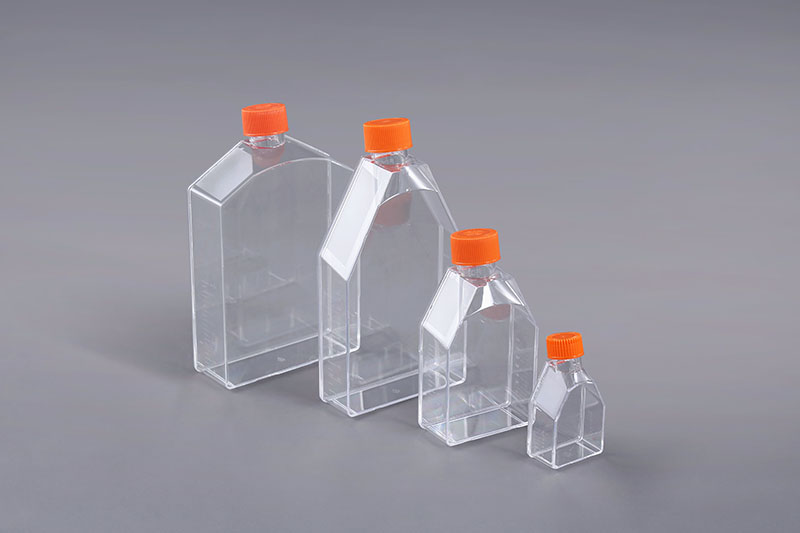เป็นวัสดุสิ้นเปลืองเซลล์ที่เหมาะสำหรับการเพาะเลี้ยงเซลล์และเนื้อเยื่อขนาดกลางในห้องปฏิบัติการ ข้อกำหนดทั่วไป ได้แก่ 25cm² 75cm² 175cm² 225cm² ฯลฯ และมีการใช้กันอย่างแพร่หลายในศูนย์เทคโนโลยีการเพาะเลี้ยงเซลล์ขวดเพาะเลี้ยงเซลล์ทำจากวัตถุดิบโพลีสไตรีนโปร่งใส ซึ่งมีคุณสมบัติทางแสงที่ดีเยี่ยม และสะดวกสำหรับการสังเกตด้วยกล้องจุลทรรศน์ ตามประเภทต่าง ๆ ของเซลล์ที่เพาะเลี้ยง มันถูกแบ่งออกเป็นพื้นผิวที่ชอบน้ำ TC และพื้นผิวที่ไม่ใช่ TC ไม่ชอบน้ำ ฝาปิดมีสองประเภท: ฝาปิดซีลและฝาปิดช่องระบายอากาศ มีเมมเบรนกรองแบบไม่ชอบน้ำ 0.2μm ในฝาปิดที่ระบายอากาศได้เพื่อให้มีการแลกเปลี่ยนก๊าซปลอดเชื้อ เพื่อลดความเสี่ยงของมลภาวะ ส่วนใหญ่จะใช้สำหรับการเพาะปลูกแบบเปิด ฝาปิดผนึกมักใช้ในการเพาะเลี้ยงแบบสุญญากาศเพื่อให้แน่ใจว่ามีอากาศถ่ายเท และยังสามารถใช้สำหรับการเพาะเลี้ยงแบบเปิดเมื่อคลายเกลียวฝาขวดออกขวดเพาะเลี้ยงเซลล์
ด้านข้างของขวดเพาะเชื้อเซลล์มีมาตราส่วนที่ชัดเจน ซึ่งสามารถปรับปรุงความถูกต้องของการเพาะเลี้ยงเซลล์ได้ สารละลาย. ส่วนคอขวดได้รับการออกแบบด้วยฝ้า ซึ่งสะดวกสำหรับการทำเครื่องหมายเพื่อแยกความแตกต่างของขวดเพื่อวัตถุประสงค์ในการทดลองที่แตกต่างกัน การออกแบบแนวเส้นตรงที่ด้านหลังช่วยให้วางขวดเพาะเลี้ยงได้ง่ายขึ้นและป้องกันไม่ให้หลุดออก การออกแบบคอกว้างช่วยให้ปิเปตและที่ขูดเซลล์เข้าไปในขวดได้ทุกมุม
สามารถใช้สำหรับการเพาะเลี้ยงเซลล์ Vero, เซลล์ HEK 293, เซลล์ CAR-T, MRC5, เซลล์ CEF และอื่นๆ เซลล์ยึดเกาะ นอกจากนี้ยังสามารถใช้สำหรับการเพาะเลี้ยงเซลล์แขวนลอยแบบคงที่ เช่น เซลล์ CHO เซลล์แมลง เซลล์ BHK21 และเซลล์ MDCK
ขวดเพาะเลี้ยงเซลล์cell culture flasks can be used for the culture of Vero cells, HEK 293 cells, CAR-T cells, MRC5, CEF cells and other adherent cells, It can also be used for static culture of suspension cells such as CHO cells, insect cells, BHK21 cells and MDCK cells.
The FAI climbed 5.9 percent year-on-year in the first 11 months of 2018, quickening from the 5.7-percent growth in Jan-Oct, the National Bureau of Statistics (NBS) said Friday in an online statement.
The key indicator of investment, dubbed a major growth driver, hit the bottom in August and has since started to rebound steadily.
In the face of emerging economic challenges home and abroad, China has stepped up efforts to stabilize investment, in particular rolling out measures to motivate private investors and channel funds into infrastructure.
Friday's data showed private investment, accounting for more than 60 percent of the total FAI, expanded by a brisk 8.7 percent.
NBS spokesperson Mao Shengyong said funds into weak economic links registered rapid increases as investment in environmental protection and agriculture jumped 42 percent and 12.5 percent respectively, much faster than the average.
In breakdown, investment in high-tech and equipment manufacturing remained vigorous with 16.1-percent and 11.6-percent increases respectively in the first 11 months. Infrastructure investment gained 3.7 percent, staying flat. Investment in property development rose 9.7 percent, also unchanged.
 English
English



















































